History
The National Super Computing Center has been providing supercomputing resources from 1988 to the present. Starting with Cray 2S, Korea’s first supercomputer in 1988, a new system is continuously introduced every five years. Currently, we are operating our 5th supercomputer.
History of Korea supercomputers
| No. | System | Theoretical performance (TFlops) |
Top 500 ranking (At the time of introduction) |
Introduction year |
Introduction amount |
|---|---|---|---|---|---|
| 1st | Cray 2S | 0.002 | - | 1988 | $22.5million |
| 2nd | Cray C90 | 0.015 | 23 | 1993 | $32.5million |
| Assistance | Cray T3E | 0.115 | 33 | 1997 | - |
| 3rd | NEC SX-5/6 | 0.240 | - | 2001 | $6million |
| IBM p690(1st) | 0.665 | 158 | 2002 | IBM p690(1st) | |
| IBM p690(1st) | 3.699 | 42 | 2003 | ||
| Assistance | P4 Cluster | 0.435 | 334 | 2002 | Build-in |
| 4th | Gaia1(IBM p5 595) | 5.9 | - | 2008 | $49million |
| Tachyon1(SUN Blade6048) | 28.2 | 131 | 2008 | ||
| Gaia2(IBM p6 595) | 30.7 | 395 | 2009 | ||
| Tachyon(SUN Blade6275) | 300 | 14 | 2009 | ||
| 5th | Nurion(Cray CS500) | 25,700 | 11 | 2018 | $48million |
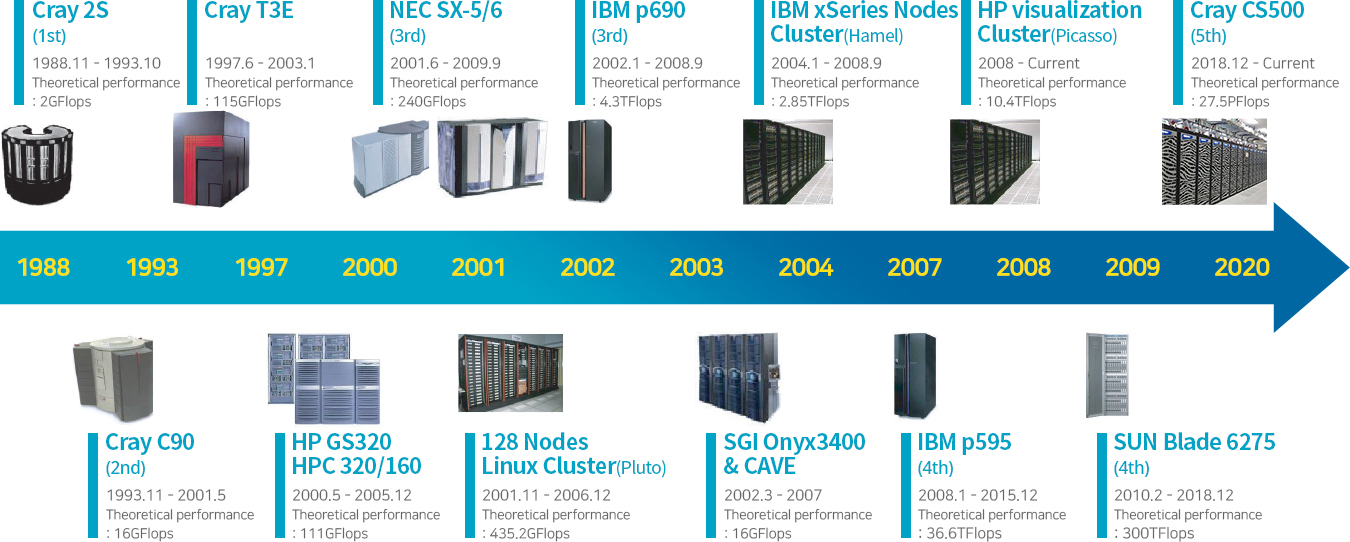
Operation Status
1988
1993
- 1988~1993
- Introduction and operation of No. 1
- Introduction 1st national supercomputer CRAY-2S
- National Supercomputer No. 1 CRAY-2S operation in December 1988 (KAIST System Engineering Center) 2GFlops performance, 4 CPUs, 128MM memory, 60GB disk, UNICOS operating system
- National Supercomputer Operation Project (1988-1993) began with the aim of building and activating an environment for supercomputers
- Accurately forecasted the pathway of Typhoon Berry in September 1989 and Mirial in September 1991 and utilized various fields at industrial and research institutes such as the Korea National Oil Corporation's exploration of continental shelf oil.
1993
2000
- 1993~2000
- Introduction and operation of No. 2
- CRAY-YMP C916/512 for National Supercomputer No. 2
- National Supercomputer No. 2 CRAY-YMP (CRAY C90) was introduced in November 1993. 16GFlops performance, 16 CPUs, 512MM memory, 203GB disks It was the latest model of its kind, with only 10 systems installed and operated globally at the time.
- 2nd phase operation project (1994-1998) started to focus on improving technical research and utilization of supercomputers to the level of advanced countries
- Supercomputer users increased dramatically due to the activation of the research and development network in 1995.
- Introduction CRAY T3E to supplement performance for No. 2 in 1997
Large parallel processing system with 115GFlops performance, 128 CPUs, 16GB memory, 240GB disk
※As of 1994, 60 percent of the TOP500 supercomputers in the world were the MPP type. This type of system was becoming popular and the areas utilized ever more varied.
- In 1997, introduction of Symmetric Multi-processor system
- 5th-year procuration cycle system changed to 2nd or 3rd-year procuration due to change in the domestic and international environment such as the IMF
- In 2000, the symmetric multiprocessor system, COMPAQ GS320 and HPC160/320 introduced and serviced in July. GS320 had 46.8GFlops performance, 32 CPUs and 32GB of memory.
- In addition, SGI Onyx3400 Infinity Reality 3 System was also introduced to help effective visualization of their supercomputing results.
2000
- 2000
- In 2000, changed project mode
- In 1999, the project mode switched from the traditional project method focused on resource allocation to the expansion of demand for supercomputers to an active project method Switch policies from simple providers to regulators who allocate resources As a part of this policies, the strategic resource allocation system was started from January 2000 to intensively support supercomputer resources and expertise to key research projects.
- The new policy produced a great deal of published studies and new theories. The opportunity arose to pioneer new technology and new learning through discovering big challenges
2001
2007
- 2001~2007
- Introduction and operation of No. 3
- National Supercomputer No. 3 (IBM p690) introduction (2001, 2003)
- Ranking as 42nd supercomputer performance(Top500) in the world at the time of introduction(Nov, 2003) SMP Cluster System consisting of 21 IBM p690 with 672 POWER4 CPUs Theoretical performance at 4.3 TFlops with 4.3 TByte main memory, 100 TByte disk storage
- NEC SX5/6a, a vector-type supercomputer for existing users, was also introduced (0.24 TFlops performance)
- In 2004, a cluster system of the next generation supercomputer type, Hammel, was introduced 512 CPUs, 2.86 TFlops performance
- Since the introduction of No. 4 in 2008, Nobel and Hamel have donated to 10 domestic institutions
2008
2017
- 2008~2017
- Introduction and operation of No. 4
- As a Cluster type, Tachyon1 and 2, and Shared Memory (SMP) type, Gaia1 and 2, total performance was approx. 360 TFlops As a single system, the Tachyon2 is the largest among No. 4 supercomputers with 3,200 nodes, 25,600 cores, and 300TFlops. The system was the most popular and main part of the No. 4 supercomputers.
- Commercial application software support Supported representative commercial software, such as structural mechanics, fluid thermodynamics, chemistry/life sciences Supported 14 commercial and open-source software products
-
4th National Supercomputer
(Unit: TFlops, number, TB)
4th National Supercomputer division cluster Shared Memory Model (SMP) Tachyon 1
(SUN B6048)Tachyon 2
(SUN B6275)Gaia 1
(IBM p595)Gaia 2
(IBM p6)Theoretical performance(Rpeak) 24 300 5.9 30.7 Number of nodes 188 3,200 10 24 Processor AMD Opteron 2GHz
(Barcelona)Intel Xeon X5570 2.93GHz
(Nehalem)POWER 5+ (2.3GHz) POWER 6 (5GHz) Number of CPUs 3,008 25,600 640 1,536 Memory(TB) 6.0 76.8 2.6 9.2 Storage(TB) 207 1,061 63 336 System 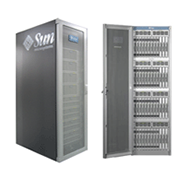
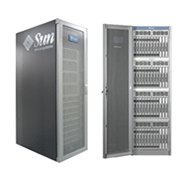
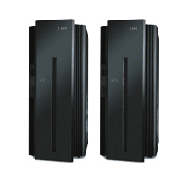
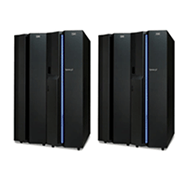
- Tape library system operation for backup and bulk data archiving Operated tape libraries that allowed storage and recovery of data faster and avoid data loss Performed backups with up to 2.5PB of tape libraries Implemented backup policies that ensured optimal performance and reliability
2018
- 2018~
- Introduction and operation of No. 5
-
A manycore CPU (configured with 68 cores) system with performance of 3 teraflops or approximately 1/100 of the 4th system
It is composed of about 8,300 (about 560,000 cores) CPUs and leads various advanced researchs including the 4th industrial revolution in Korea: artificial intelligence, internet of things, big data, etc. Includes high-performance interconnects, high-capacity storage, and burst buffers to handle application-generated I/O requests seamlessly
 National Supercomputing Center
National Supercomputing Center